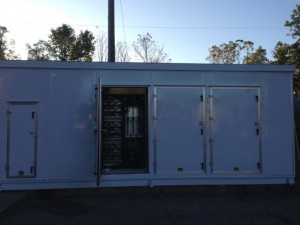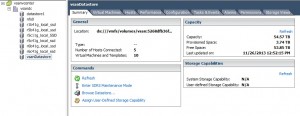VMware vSAN on Open Compute
As we all know, the largest cost component of virtualization is typically shared storage. Be it Fibre Channel, NAS or iSCSI, it’s all expensive! Let alone a flash based array like Tinri or Whiptail.
One of the use cases of our OCP (Open Compute Platform) Container (above) gear is to test VMware’s new vSAN product. With vSAN, VMware not only removes the expensive disk cost out of the picture, but they also lock you in to using their Hypervisor exclusively.
What is vSAN?
vSAN is Software Defined Storage (SDS), which is a key component of the Software Defined Data Center (SDDC) approach that VMware is taking with their product line. vSAN effectively aggregates local server disks into a cluster to create shared storage. It is object-based storage that is integrated into the Hypervisor itself.
vSAN uses a combination of SSD and non-SSD drives for high-performance yet cost advantageous shared storage. Extending possible footprint of the VMware product line even further into the small to medium business realm. Read more about vSAN here.
Why vSAN on OCP?
Why vSAN on OCP? Because I have a lot of cheap fast disk, and I need a lot of cheap fast shared storage :) With our OCP Open Vault JBOD units, we have 15 SAS/SATA/SSD drives attached to each OCP Windmill server. Providing the flexibility required to integrate SSD’s in with the SAS/SATA drives. Add the fact that I have a pair of 10GB NIC’s for the vSAN traffic to ride on already in place, OCP is a perfect vSAN platform!
How to run vSAN on OCP?
It’s actually pretty easy, first step is you need to set your SCSI controller to JBOD or pass-through mode. Our Windmill servers have the LSI MEGARAID SAS 9286CV-8E SCSI controller, so the first thing to do is to set the controller to JBDO mode using MegaCli:
./MegaCli -AdpSetProp -EnableJBOD 1 -aALL
The next step is to go through each drive and set it to JBOD mode as well using MegaCli:
i=0; while [ $i -le 14 ] ; do ./MegaCli -EnableJBDO -PhysDrv [39:${i}] ; i=`expr $i + 1`; done
Once that is complete, you simply create the vSAN datastore using the vSphere Web Client, as the vSAN functionality is not available to the standalone vSphere Client.
vSAN on OCP Results?
I’ve had complete success, incredible performance, easy to setup and configure and cheap above all! I fully expect vSAN to take off like wildfire, especially on OCP gear with the ability to house so many disks so cheaply.


